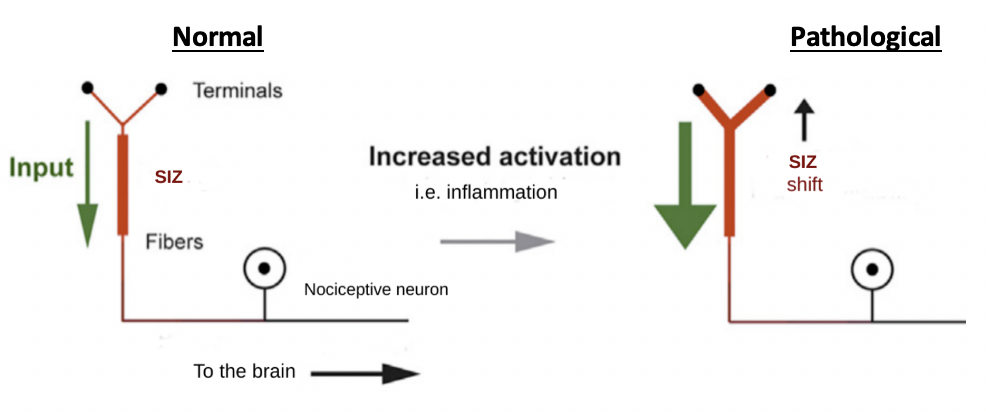By Arthur Berrou
The sensation of pain protects organisms against potential dangers. This role is fulfilled by cells called nociceptive neurons, which are neurons devoted to pain. Nociceptive neurons convey noxious stimuli using electrical impulses, known as ”spikes,” from a peripheral tissue such as the skin and into the brain, where it is interpreted as pain. Pain intensity depends on the number of spikes: The more spikes in a short time, the more painful the sensation.
The conversion of a noxious stimulus into electrical signals originates in the terminals of the nociceptive neurons. However, this initial signal at the terminals fades away as it propagates along the nociceptive fiber. It is only when it reaches the “spike initiation zone” (SIZ) that a spike is triggered. Once a spike is triggered, the electrical signal propagates without attenuation up to the brain. This is why the location of the SIZ is important: the closer it is to the terminal, the more reliable the transmission of noxious stimuli.
Dr. Alex Binshtok and his team sought to determine the location of the SIZ in nociceptive neurons of mice. “To our knowledge, we were the first to study spike initiation in physiological conditions,” Dr. Binshtok said.
Ph.D. student Robert Goldstein in the Binshtok lab used a technique called fluorescence imaging, which essentially is an ultrasensitive camera that can detect electrical signals in nociceptive neurons. They also used a neat manipulation to detect the SIZ: Using a local application of chemicals, they blocked the proteins responsible for spike initiation. Since the blocking was done in a spatially restricted manner, they could determine the exact location of the SIZ. Remarkably, it turns out that the SIZ is located in the fibers of nociceptive neurons, just downstream of their terminals (left part of the figure).
Furthermore, the researchers investigated whether the location of the SIZ can change in pathological conditions such as inflammation. Indeed, under conditions of painful inflammation, the location of the SIZ shifted toward the terminal, thereby increasing the excitability of the neuron, and therefore increasing pain sensation as well (right part of the figure). How these findings generalize to nociceptive neurons in the rest of the body still needs to be tested. Nevertheless, it opens the door to new clinical strategies for the treatment of inflammatory pain.

Left: The normal condition, whereby “spikes” in pain neurons are generated in a restricted region of the nerve terminal (red region).
Right: A pathological condition (e.g., nerve inflammation), whereby the region generating the spikes expands, with the consequence of an enhanced pain sensation.
Figure adapted from Sharon R. Ha and Matthew N. Rasband. The SIZ of Pain. Neuron, volume 102, issue 4, 22 May 2019, Pages 801-812.e5.
A link to the original paper:
https://www.sciencedirect.com/science/article/pii/S0896627319302120

